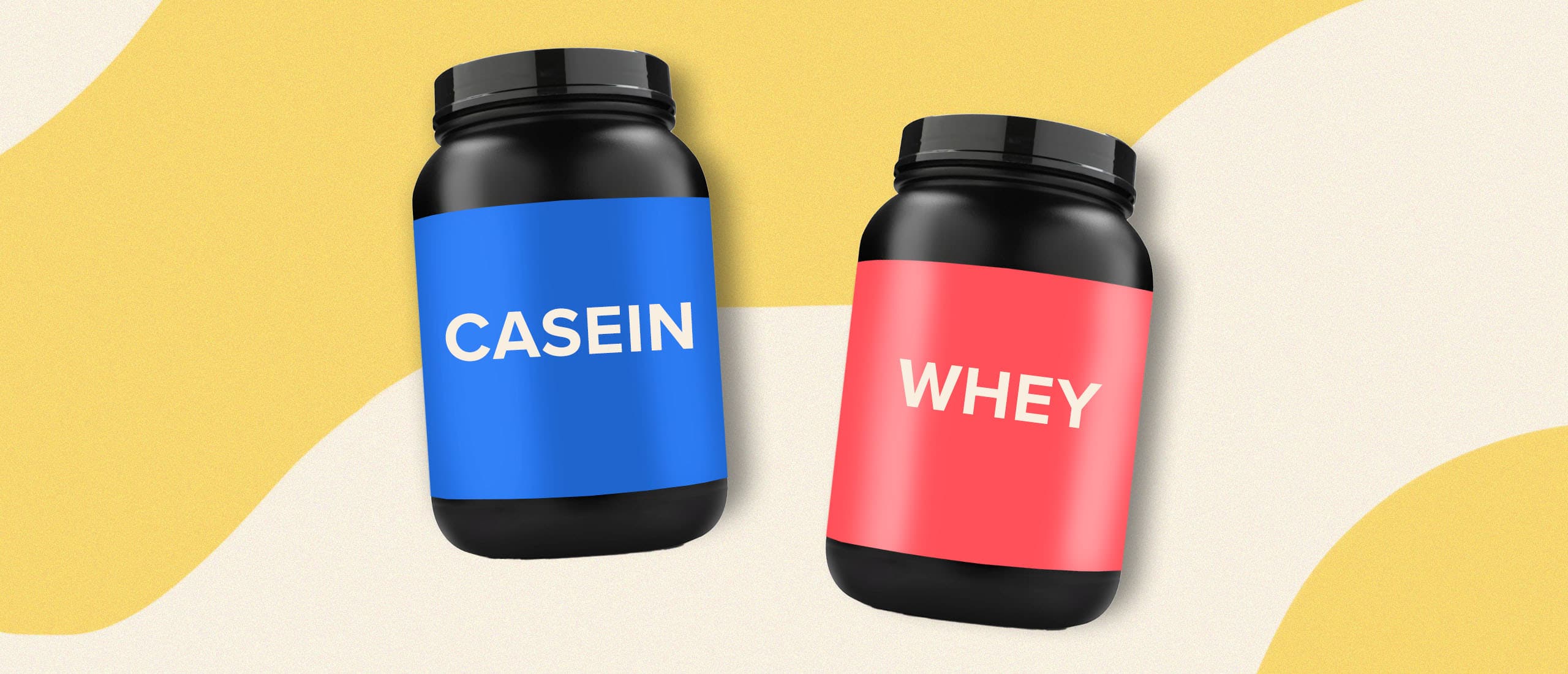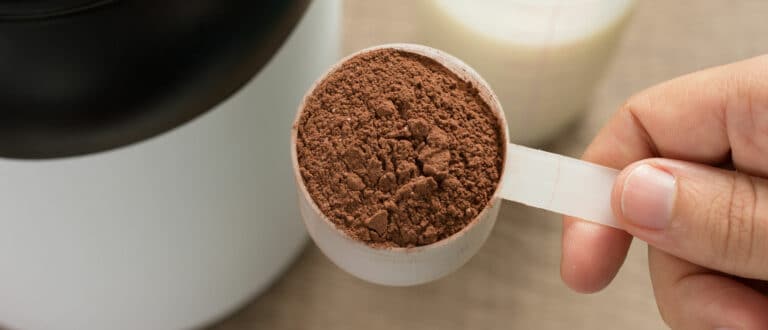Casein Versus Whey Protein: Which Is Better for Gains
- By Sydney Bueckert, NASM C.P.T., C.E.S., F.N.S., G.P.T.S.
- expert reviewed by Imashi Fernando, MS, RD
- April 25, 2023
If you’re on the gains train, a steady diet of protein combined with resistance training can almost guarantee muscle growth (1). But packing in protein in the form of whole foods isn’t always easy (take it from someone who’s hit the infamous threshold of plain chicken breast).
That’s where protein powder comes in.
“Protein powders can be especially useful for those practicing restrictive diets or engaging in long hours of intensive training where it may be a challenge to meet 100 percent of your daily protein needs with food alone,” says Imashi Fernando, MS, RD.
There are a ton of protein powders to choose from, but whey and casein are two of the best sources of high-quality protein, containing all nine essential amino acids. Which is best for you? We break down the key benefits, and when to use casein versus whey for best results below.
Key Differences Between Casein and Whey
How They’re Made
Both whey and casein come from milk. As long as you don’t have a cow’s milk allergy, these protein powders are easily digested and absorbed (2).
Interestingly, whey and casein are separate byproducts of cheese production. During cheese making, special enzymes or acids are added to heated milk. These enzymes are what cause the milk to coagulate (or become solid) and separate from the liquid.
The liquid is the whey, and the curds are casein. Both are then washed and dried and turned into powdered form. Different brands then take this powder and formulate their own blends of other vitamins and minerals, and added ingredients to make the powder taste and blend better.
Absorption
During the digestion process, your body breaks down protein into small molecules called amino acids which are then absorbed into your bloodstream. Levels of amino acids stay elevated in your blood for four to five hours after consuming casein, but only 90 minutes after consuming whey (3).
That’s because casein forms curds when exposed to the acid in your stomach—a process that doesn’t happen to whey. These curds lengthen the time it takes for your body to digest and absorb casein.
Casein’s slow, steady release of amino acids makes it ideal for fasting situations, such as sleep (4). Whey’s quick absorption deems it the perfect bookend to your workouts as it will immediately kickstart the muscle repair and rebuilding process (5, 6).
Amino Acid Profile
Amino acids are the building blocks of protein. Whey and casein each have a unique blend of amino acids. Whey protein contains more of the branched-chain amino acids (BCAAs) leucine, isoleucine, and valine. Whereas, casein contains a higher portion of the amino acids histidine, methionine, and phenylalanine.
All essential amino acids are beneficial for muscle-building, leucine, in particular, jump-starts the process (7)—yet another reason whey protein is ideal immediately before or after a workout.
That doesn’t mean casein won’t help with building muscle. “Since both whey and casein are complete proteins, meaning they contain all nine essential amino acids, you really cannot go wrong with either protein,” says Fernando, “especially when taken as part of a balanced diet with other sources of protein.”
Muscle Growth
Whey is anabolic, meaning it builds muscle. Downing a whey protein shake leads to a rapid spike in blood amino acid levels—which initiates muscle protein synthesis (the process of producing new muscle protein).
Casein is anti-catabolic, meaning it prevents muscle breakdown. Throw back a serving of casein and a steady stream of amino acids will be released over time—which helps to keep muscle tissue breakdown at bay.
For muscle growth to happen, muscle protein synthesis needs to be greater than muscle breakdown. Since whey increases muscle protein synthesis and casein prevents muscle breakdown, both proteins, taken strategically can help you build muscle.
If that sounds too complicated, no need to obsess over it. Several studies have found for muscle growth, the amount of protein you get throughout the day is more important than timing (8, 1).
Nutrition Benefits
Though the macro breakdown is similar, the nutritional makeup of casein and whey is different. Each has unique benefits worthy of a place in your routine.
Casein contains several bioactive peptides that have been shown to benefit your immune system and digestive systems (9). Some bioactive peptides in casein might lower blood pressure and reduce the formation of blood clots (10). They also bind and carry minerals like calcium and phosphorus (which are key in muscle contraction).
Whey protein is packed with immunoglobulins which boost your immune system (11). The immunoglobulins in whey are known to have antimicrobial properties, either killing or slowing the growth of harmful microbes, such as bacteria and viruses (12). Whey is also packed with antioxidants, which protect against oxidative stress—a factor that can cause muscle damage if left untreated (13).
Which Is Better: Casein Versus Whey Protein?
The best protein powder for you will depend on your nutrition goals and when you plan to take it. The chart below shows just how little the difference is between whey and casein when it comes to straight macro breakdown.
|
Per standard Scoop |
||
|
Calories |
120 |
120 |
|
Fat |
1.5 grams |
1 gram |
|
Carbohydrate |
2 grams |
4 grams |
|
Protein |
24 grams |
24 grams |
|
Calcium |
10% RDI |
40% RDI |
|
Potassium |
4% RDI |
4% RDI |
Though Fernando points out, the nutrition may vary per brand, flavor, and product so always read nutrition labels before pulling the trigger. “In addition to the nutrition label, check the ingredients list,” she says. “Pick a protein powder free of fillers, additives, or added sugars which can contribute to weight gain and insulin resistance, and increase your risk of diabetes.”
She also recommends eyeballing the label to see if the product undergoes third-party testing, or has any certifications that indicate the quality. A label stamped with NSF Certified for Sport ensures there are no banned substances—a critical distinction for competitive athletes.
Other factors to consider:
- Casein protein powder is generally more expensive than whey
- Whey protein tends to mix and taste better than casein
- You can buy a blend that contains both (but casein may slow the breakdown of whey, so it may be best to purchase and consume them separately at the ideal time)
When and How to Use Whey Protein
The quick digestion of whey makes it great for before, during, or after workouts because it will fuel your muscles quickly making amino acids readily available for protein muscle synthesis as needed.
“Both pre- and post-workout snacks should contain adequate carbs for energy provision and replenishing glycogen stores,” says Fernando. “Aim for at least 2:1 carbs to protein before your workout (including at least 15 to 30 grams of carbs) and 3:1 carbs to protein after your workout.”
She also suggests that even when protein powder is involved, use your snacks as an opportunity to incorporate more grains, fruits, vegetables, and healthy fats to round out your diet. Here’s how.
For a pre-workout snack, Fernando recommends high-protein overnight oats topped with berries for your daily dose of vitamin C and antioxidants, and chia seeds for a boost of healthy omega-3 fats. To make them combine:
- ½ cup rolled oats
- ½ scoop whey protein powder
- ½ cup milk
- ¼ cup yogurt
- 1 tbsp chia seeds
- Berries and nuts (to top)
After a workout, Fernando likes to fuel up with a protein shake. Her blend includes a handful of spinach which is rich in iron and magnesium. To make it, combine the following in a blender:
- 1 scoop protein powder
- 1 cup milk
- 1 handful of spinach
- ½ banana
- ½ cup berries
- 1 tbsp chia seeds
When and How to Use Casein Protein
Casein, on the other hand, could be a detriment before or after a workout when your muscles are looking for quick, accessible fuel. This same quality makes it ideal for staving off hunger and providing slow and steady nutrition before fasting such as before bed, or a morning packed with non-stop meetings. The slow release of amino acids will keep you feeling satiated and spare muscle breakdown.
There are a few things to consider when eating before bed. The first is timing. “Ideally a nighttime snack should be at least two hours before bed, if not earlier,” says Fernando.
She points out that the best pre-snooze snack is a pairing of whole-grain carbs and protein. This combo promotes good sleep, maintains muscle, and balances blood sugars overnight. Avoid pairing your snack with high-fat foods as fat takes longer to digest and may cause gastrointestinal discomfort as you lie down for bed.
Here’s how she pairs casein protein powder with whole foods at night for best results:
- Protein Shake: ½ scoop casein protein powder + 1 cup milk + ½ banana
- Protein Pancake: mix ½ scoop casein protein powder into whole grain pancake batter
Fernando warns only those who are highly physically active who need help meeting their high protein requirements warrant eating a snack before bed. For others, a late-night snack adds calories you don’t need. Be honest with yourself about which camp you fall in.
Best Whey Protein Powder
Looking to track down the best whey protein powder? Here, the whey protein powders that check all of Fernando’s nutrition boxes.
Best Casein Protein Powder
For a boost of protein that will keep you satiated for hours, try Fernando’s top casein protein powder picks.
References
1. Schoenfeld, B. et al (2013). The effect of protein timing on muscle strength and hypertrophy: a meta-analysis. https://www.ncbi.nlm.nih.gov/pmc/articles/PMC3879660/
2. Pereira, P. (2014). Milk nutritional composition and its role in human health. https://pubmed.ncbi.nlm.nih.gov/24800664/
3. Dangin, M. et al (2002). Influence of the protein digestion rate on protein turnover in young and elderly subjects. https://pubmed.ncbi.nlm.nih.gov/12368423/
4. Trommelen, J. et al (2018). Presleep dietary protein-derived amino acids are incorporated in myofibrilla protein during post-exercise overnight recovery. https://pubmed.ncbi.nlm.nih.gov/28536184/
5. Schoenfeld, B. et al (2017). Pre- versus post-exercise protein intake has similar effects on muscular adaptations. https://www.ncbi.nlm.nih.gov/pmc/articles/PMC5214805/
6. Montom, R. et al (2020). A systematic review, meta-analysis and meta-regression of the effect of protein supplementation on resistance training-induced gains in muscle mass and strength in healthy adults. https://bjsm.bmj.com/content/52/6/376
7. Stark, M. et al (2012). Protein timing and its effects on muscular hypertrophy and strength in individuals engaged in weight-training. https://www.ncbi.nlm.nih.gov/pmc/articles/PMC3529694/
8. Wirth, J. et al (2020). The Role of Protein Intake and its Timing on Body Composition and Muscle Function in Healthy Adults: A Systematic Review and Meta-Analysis of Randomized Controlled Trials. https://pubmed.ncbi.nlm.nih.gov/32232404/
9. Mohanty, D. et al (2016). Milk derived bi9oactive peptides and their impact on human health—A review. https://www.ncbi.nlm.nih.gov/pmc/articles/PMC4992109/
10. Fekete, A. et al (2015). Casein-Derived Lactotripeptides Reduce Systolic and Diastolic Blood Pressure in a Meta-Analysis of Randomised Clinical Trials. https://www.ncbi.nlm.nih.gov/pmc/articles/PMC4303860/
11. Ng, T. et al (2015). Antiviral activities of whey proteins. https://pubmed.ncbi.nlm.nih.gov/26198883/
12. Moreno-Exposito, L. et al (2018). Multifunctional capacity and therapeutic potential of lactoferrin. https://pubmed.ncbi.nlm.nih.gov/29307524/
13. Zhou, L. et al (2015). Effect of whey supplementation on circulating C-reactive protein a meta-analysis of randomized controlled trials https://pubmed.ncbi.nlm.nih.gov/25671415/














